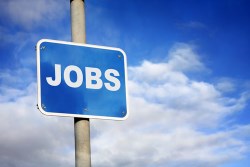Nonfarm payrolls rose a seasonally adjusted 280,000 in May, the Labor Department said Friday, led by gains in professional and business services, leisure and hospitality and health care.
Revisions showed employers added 32,000 more jobs in March and April than previously estimated. April's payroll gain of 221,000 was revised down from an initially reported 223,000. But March's payroll gain of 119,000 was revised up from a previously reported 85,000.
"This is a strong jobs report and should act as a clear counter to arguments that the economy has lost momentum," economists John Ryding and Conrad DeQuadros, of RDQ Economics, said in a note to clients.
The unemployment rate, which is obtained from a separate survey of U.S. households, was 5.5% in May, up slightly from 5.4% the prior month. But the increase was for good reason: more people were looking for work last month, suggesting Americans are more confident about their job prospects.
Economists surveyed by The Wall Street Journal had predicted payrolls would rise by 225,000 in May and the unemployment rate would hold steady at 5.4%.
The stronger-than-expected report should reassure Fed officials the economy is healthy enough to begin raising interest rates at its September policy meeting, economists said.
"The stellar employment report has kept 2015 hikes in play, though we believe that the Fed will want to see this labor market buoyancy sustained and translated into higher economic activity before moving on rates," TD Securities analyst Millan Mulraine said in a note to clients.
Wages, meanwhile, rose at a healthy pace. Average hourly earnings of private-sector workers rose by 8 cents, or 0.3%, to $24.96 in May. Economists had expected a 0.2% increase in wages from April.
From a year earlier, hourly earnings rose 2.3% in May, a little better than the 2% annual pace of recent years and the highest increase since August 2013.
"Hourly earnings are on the move, and, over the past 30 years, nothing has been more closely correlated with Fed action than wage gains," Pantheon Macroeconomics Chief Economist Ian Shepherdson said in a note to clients. "If the June employment report is as strong as this one, a July hike can't be ruled out."
The May report is an initial estimate and is likely to be revised as the government collects fresher data. But for now the report suggests employers continue to invest in new hires despite a recent string of mixed economic data.
Severe winter weather, a stronger dollar and a labor dispute that snarled activity at West Coast shipping ports all held back growth in the first quarter. Gross domestic product shrank by a 0.7% annual rate from January to March, the Commerce Department said last week.
The first-quarter slowdown is reminiscent of the first quarter of 2014, when U.S. economic output contracted before rebounding strongly in the spring and summer.
Many economists think the first-quarter woes were temporary and that the economy will rebound this spring. Fed officials predict a bounce-back as well, and most have said they expect to begin raising the central bank's benchmark short-term interest rate from near zero later this year.
Still, some policy makers have raised concerns about the first-quarter slowdown.
Federal Reserve Governor Daniel Tarullo on Thursday said the U.S. economy appears to have "lost some momentum" and may not recover as quickly from the rough first quarter as it did in 2014.
"There are more questions at this point in 2015 than there were at this point in 2014," Mr. Tarullo said at a conference in New York.
The International Monetary Fund also slashed its forecasts for U.S. economic growth Thursday, and called on the Fed to hold off on raising interest rates until 2016. The IMF now expects the U.S. economy to grow 2.5% this year, down from an earlier estimate of 3.1% in April.
The Fed has said that, assuming the labor market continues to improve, it will raise rates when officials are "reasonably confident" that inflation will move back toward 2%.
Friday's report showed there is still room for improvement in some corners of the labor market.
A broad measure of unemployment that includes Americans stuck in part-time jobs or people who wanted work but were not in the labor force was unchanged in May at 10.8%. And the average workweek remained the same last month, at 34.5 hours.
The share of Americans with jobs or looking for work remains historically weak. The labor-force participation rate ticked up to 62.9% from 62.8%, a sign of progress but still near the lowest level since the late 1970s.
But the number of discouraged workers-people who were not looking for work because they believed no jobs were available for them-dropped sharply compared with a year ago, to 563,000 from 697,000 in May 2014.
Job growth was also broad-based last month. Professional and business services added 63,000 jobs. Leisure and hospitality payrolls grew by 57,000. Health-care, retail trade and construction also added positions. The mining sector, covering energy industries, fell by 17,000.
"The March slowdown looks like a hiccup in hindsight," Deutsche Bank economist Jay Feldman said in a note.













 U.S. employers ramped up hiring last month and wages picked up after a winter lull, signs of an accelerating economy that nudge the Federal Reserve toward a September interest-rate increase.
U.S. employers ramped up hiring last month and wages picked up after a winter lull, signs of an accelerating economy that nudge the Federal Reserve toward a September interest-rate increase.